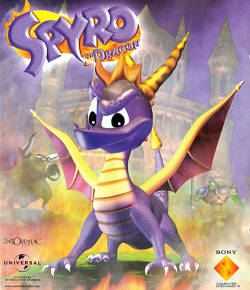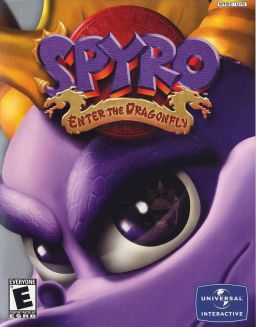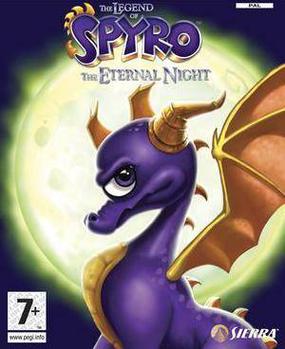Insomniac Games, Inc. is an American video game developer based in Burbank, California and part of PlayStation Studios. It was founded in 1994 by Ted Price as Xtreme Software, and was renamed Insomniac Games a year later. The company is most known for developing several early PlayStation mascots, Spyro the Dragon, Ratchet and Clank, as well as the Resistance franchise, 2014's Sunset Overdrive and the Marvel's Spider-Man series with Marvel Games. In 2019, the studio was acquired by Sony Interactive Entertainment, becoming a part of SIE Worldwide Studios.

Spyro is a platform game series originally created by Insomniac Games as an exclusive for Sony's PlayStation console. The series features the adventures of the main protagonist of the same name, a dragon. Since the series' introduction in 1998, there have been numerous sequels and a reboot trilogy. The series was originally produced by Universal Interactive, later became known as Vivendi Games; the rights to the intellectual property were acquired by Activision after its merge with Vivendi in 2008.

Mark Evan Cerny is an American video game designer, programmer, producer and media proprietor.

Crash Bash is a 2000 party video game developed by Eurocom Entertainment Software in association with Cerny Games and published by Sony Computer Entertainment for the PlayStation. It is the fifth title in the Crash Bandicoot series and the first in the party genre. The game includes a collection of 28 mini-games playable within three modes of gameplay, as well as eight playable characters from the Crash Bandicoot series.

Spyro the Dragon is a 1998 platform game developed by Insomniac Games and published by Sony Computer Entertainment for the PlayStation. The first game in the Spyro series, it stars the title character, a young purple dragon named Spyro, and his dragonfly friend, Sparx, who must journey across the Dragon Kingdom to defeat Gnasty Gnorc, who has overtaken the 5 dragon Homeworlds by trapping the other dragons in crystal and turning their hoard of gems into an army of minions. Spyro the Dragon is an open-ended 3D platformer, featuring large, sprawling levels in which the player must locate collectable items, among which are gemstones, crystallized dragons, and stolen dragon eggs. Spyro's abilities as a dragon include fire breath, a head-on charging attack, and a mid-air glide which he can use to scale large distances, all of which must be used strategically to find items and defeat enemies.

Spyro: A Hero's Tail is a 2004 platform game developed by Eurocom Entertainment Software and published by Vivendi Universal Games for the PlayStation 2, GameCube, and Xbox. It is the fifth console game in the original Spyro series and the ninth game in the series overall. Per usual, players act as the titular dragon collecting objects, platforming, flying, headbutting and breathing fire onto enemies to save the Dragon Realms. This time, he collects Dark Gems, which corrupt the land with maniacal creatures and deadly plants, planted by a banished Dragon Elder Red. Other characters, such as Sparx the Dragonfly, Hunter the Cheetah, Sgt. Byrd the Penguin, and newcomer Blink the Mole, are playable in mini-game stages.

Spyro: Season of Ice is a 2001 platform game developed by Digital Eclipse and published by Universal Interactive Studios for the Game Boy Advance. It acts as an alternate sequel to the first three games along with Spyro 2: Season of Flame and Spyro: Attack of the Rhynocs.

Spyro: Attack of the Rhynocs is a 2003 platform game developed by Digital Eclipse and published by Universal Interactive for the Game Boy Advance. It was the last Spyro game to release under the Universal Interactive label, as the label would be phased out shortly after the game's release. It was also the final Spyro game to be developed by Digital Eclipse, where for the next major handheld entries they would be replaced by Amaze Entertainment.

Spyro 2: Season of Flame is a 2002 platform game developed by Digital Eclipse and published by Universal Interactive for the Game Boy Advance.

Spyro: Enter the Dragonfly is a 2002 platform game developed by Equinoxe Digital Entertainment and Check Six Studios for the PlayStation 2 and GameCube, and published by Universal Interactive. It is the fourth console game in the Spyro series and the sixth overall, being the first for either of its consoles and the first main entry to not be developed by Insomniac Games.

Spyro 2: Ripto's Rage!, known as Spyro 2: Gateway to Glimmer in PAL regions, is a 1999 platform game developed by Insomniac Games and published by Sony Computer Entertainment for the PlayStation. It is the second game in the main Spyro series. A remake was released as part of the Spyro Reignited Trilogy in 2018.

The Legend of Spyro: A New Beginning is a 2006 action-adventure video game in the Spyro series. It is the first installment in The Legend of Spyro trilogy. The game was released for the Game Boy Advance, Nintendo DS, GameCube, PlayStation 2, Xbox, and mobile.

The Legend of Spyro: The Eternal Night is a 2007 action-adventure video game in the Spyro series. It is the second installment in The Legend of Spyro trilogy and the sequel to The Legend of Spyro: A New Beginning (2006). It was released for the Game Boy Advance, Nintendo DS, PlayStation 2, Wii, and mobile.

The Legend of Spyro: Dawn of the Dragon is a 2008 action-adventure video game in the Spyro series. It is the third and final installment in The Legend of Spyro trilogy and the sequel to The Legend of Spyro: The Eternal Night (2007), marking the tenth anniversary of the game series. The game was released for the PlayStation 2, PlayStation 3, Xbox 360, Wii, and mobile.
The Legend of Spyro is a game trilogy that is part of the Spyro series. It acts as a reboot to the original series. The games use a combination of close-combat and platforming gameplay, though more oriented on combat than previous games in the Spyro series. The story revolves around Spyro, the protagonist, and his efforts to stop Malefor, the Dark Master, from escaping his ancient imprisonment to bring about an armageddon upon the world.

Crash Bandicoot Purple: Ripto's Rampage and Spyro Orange: The Cortex Conspiracy are two platform games published by Vivendi Universal Games. The games are developed by Vicarious Visions for the Game Boy Advance. They were released in North America on June 3, 2004, and in Europe on June 25, 2004 under the names Crash Bandicoot Fusion and Spyro Fusion.

Spyro is a fictional character and the titular protagonist of the Spyro video game series, including The Legend of Spyro, and a guest character in the Skylanders series, first appearing in Spyro the Dragon in 1998.

Universal Interactive was an American video game publisher. The company was established on January 4, 1994, and led by Skip Paul and Robert Biniaz of MCA. It was best known for producing the Crash Bandicoot and Spyro platform game franchises.

PlayStation Underground was an American video game magazine, originally published by Sony Computer Entertainment America. The magazine focused on the PlayStation fanbase, including gaming on the original Sony PlayStation and the PlayStation 2, and was promoted as a "PlayStation fan club". Unlike its paper-based counterpart the Official U.S. PlayStation Magazine, PlayStation Underground came in the form of CD-ROMs which could be played on the PlayStation and PlayStation 2 consoles. Subscribers were also given access to a members-only website. The magazine released its first issue on March 26, 1997 and its final issue in 2001. The magazine released a total of seventeen issues during its active years. The magazine was eventually merged with Official U.S. PlayStation Magazine in 2001 when it was discontinued.

Spyro Reignited Trilogy is a 2018 platform game compilation developed by Toys for Bob and published by Activision. It includes remakes of the first three games in the Spyro series: Spyro the Dragon (1998), Spyro 2: Ripto's Rage! (1999), and Spyro: Year of the Dragon (2000). Reignited was released for PlayStation 4 and Xbox One in November 2018, while Nintendo Switch and Windows versions released in September 2019. The collection received positive reviews from critics and has sold over 10 million units as of September 2023.



















